Kristine Hughes's Blog, page 171
October 27, 2010
Ha-Ha
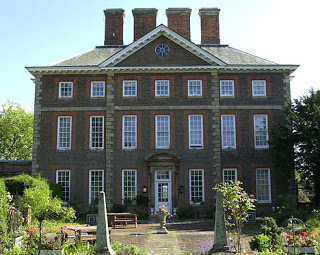
One day, I shall have a Grade I listed home in England that will come complete with a typical English garden. This garden will include a multitude of roses, fountains, statuary, a maze, a grotto, a Ha Ha and even, perhaps, a hermit. Ha! Seriously, I always think a Ha Ha gives a property a substantial feel, as though it were absolutely necessary in order to separate your Georgian pile from the multitude of cows and sheep one is wealthy enough to allow to graze on one's vast acreage. It is thought that their name, Ha-Ha, is derived from the sound persons made upon first encountering them. Ha-Has were both unexpected and amusing.
From Wikipedia: "The Ha-Ha is an expression in garden design that refers to a trench, in which is a fence concealed from view. Alternatively it can be used to mean a ditch the one side of which is vertical and faced with stone, the other face sloped and turfed, making the trench, in effect, a retaining wall (this is also sometimes known as a deer leap). The ha-ha is designed not to interrupt the view from a garden, pleasure-ground, or park, while maintaining a physical barrier at least in one direction."

Here's the Ha-Ha at Kyme Castle
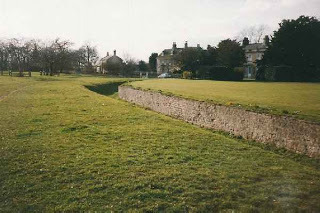
And one at Leven Hall, below This is an arrangement of a sunken wall and ditch to allow views of the countryside beyond the garden and is the earliest recorded example of a Ha-Ha in England.
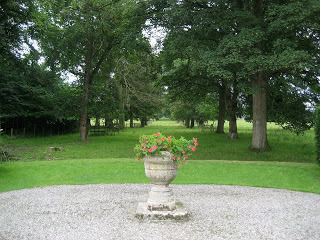
And (drumroll, please) the Ha-Ha at Burghley House
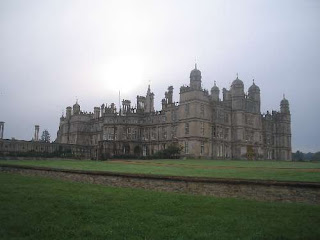
This is a sunken wall, which does not interrupt the views of a sweeping landscape, but which still does the job of keeping livestock away from gardens near a house. This feature began to form part of the English landscape in the 1720s. In 1770, Horace Walpole wrote: "No sooner was this simple enchantment made, than levelling, mowing, rolling followed. The contiguous ground of the park without the sunk fence was to be harmonised with the lawn within; and the garden in its turn was to be set free from its prim regularity, that it might assort with the wilder country without."
A Ha Ha was also incorporated into the gardens at Kew, as descrived in Volume 10 of the Kew Bulletin, published by the Royal Botanical Garden in 1896: "The gardens of Kew are not very large, nor is their situation by any means advantageous, as it is low and commands no prospects. Originally the ground was one continued dead flat, the soil was in general barren, and without either wood or water. With so many disadvantages, it was not easy to produce anything tolerable in gardening; but princely munificence, guided by a director equally skilled in cultivating the earth and in the polite arts, overcame all difficulties. What was once a desert is now an Eden.
" The task could not have been easy. But there seems reason to believe that in the main features which still survive it was the work of (William) Kent, who has been termed the 'founder of the school of landscape gardening.' By the introduction of the sunk fence or ha-ha (largely used at Kew) instead of walls or fences," he brought external scenery into his landscape effects."
In A Treatise on the Theory and Practice of Landscape Gardening by Andrew Jackson Downing (1855) the author elaborates: It is not too much to say that Kent was the leader of this class. Originally a painter, and the friend of Lord Burlington, he next devoted himself to the subject, and was, undoubtedly, the first professional landscape gardener in the modern style. Previous artists had confined their efforts within the rigid walls of the garden, but Kent, who saw in all nature a garden-landscape, demolished the walls, introduced the ha-ha, and by blending the park and the garden, substituted for the primness of the old inclosure, the freedom of the pleasure-ground.
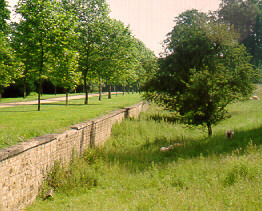
Here's a wonderful journal of the restoration of the Ha Ha at the Stow Landscape Gardens, above, where William Kent's ideas about garden design were also implemented. In 1741, Lancelot (Capability) Brown was hired as head gardener, in charge of executing Kent's designs. Ten years later, in 1751, Brown left Stowe and later became the most sought after garden designer in England.
Published on October 27, 2010 01:20
October 26, 2010
Mary Anne Clark by Jo Manning - Part Three
The Duke of York set Mary Anne up in lavish accommodations in a mini-palace at 18 Gloucester Place, and by 1805, as his official mistress, she was entertaining, as one source put it, "sumptuously". She was said to have had twenty servants, which included a housekeeper, five/six maids, two butlers, six or more other male servants (probably footmen and coachmen), and three/four chefs. She had two coaches and at least ten horses. There was also "an elegant mansion at Weybridge" for her sole use.
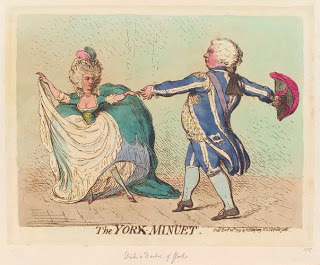
'The York-minuet' (Frederica Charlotte Ulrica Catherina, Duchess of York; Frederick, Duke of York and Albany) by James Gillray (1791)
The prince was married. He was the first of King George II's children to get married. He'd wed his cousin, Princess Frederica of Prussia, a woman noted for her extremely tiny feet, in 1791. Frederica was petite, very short, not at all attractive, and said to have bad teeth. The duke was no prize himself, described as "a giant of a man…with [a] great bluff red face…bulging eyes…ponderous belly [and a] prominent nose." Even more detailed is this from another source: "a red, blotched face…a great paunch…a purple, bulbous nose".
Though Frederica, known as Freddie, was lively, praised for her "neatness", and considered to be a sensible woman, the couple did not mesh and the marriage was not a success. They lived apart, she at Oatlands Park in Surrey, with eighteen dogs; she had many friends, among them the famous Beau Brummell. (Romance novelist Rosemary Stevens, a few years back, played with Freddie and the Beau's relationship in a series of mysteries with Brummell as a kind of Regency Sherlock Holmes. Check them out, they're fun to read!)
At Gloucester Place, Mary Anne Clarke was said to have eaten off exquisite china plates that once belonged to the family of the Duc de Bern, and to drink from crystal wine glasses that had cost upwards of "two guineas a-piece." (A guinea is a pound plus a shilling.) How much did all this cost to maintain? Mary Anne was never one to stay within a budget, as her past so well illustrates. Her talent – or one of them, at any rate – lay in extravagance.
According to Mary Anne, she received from £1,000 to £1,200 annually from the Duke of York, in monthly allotments, for the maintenance of this enormous household. (Bear in mind that, at that time, one pound was worth seventy to eighty times what it is worth today.) This is at odds with the statement of the Chancellor of the Exchequer at the 1809 trial that she was actually paid £6,000 yearly. Mary Anne countered that her payments from the Duke were irregularly doled out. (It is interesting to note here that the royal brothers received many complaints from their ladybirds over the years that payments were not always forthcoming; this has been documented by the experiences of Mary Robinson and Grace Dalrymple Elliott, among others.)
So, to supplement her income, the avaricious, luxury-loving Mary Anne Clarke hit upon a scheme. She would take the lists of army men up for promotions that were sent to her lover and add the names of soldiers who would pay her for the surreptitious promotions. Only a few each time, added at the very end of the lists to which she was privy, thanks to Frederick -- who carelessly kept them lying around -- so as not to arouse suspicion. But she got much too greedy…and she was caught. By 1809, the jig was up.
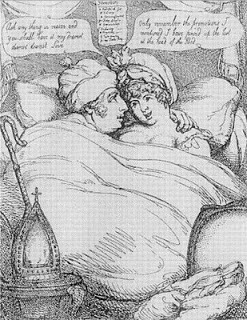
The Bishop And His Clarke Or A Peep Into Paradise… The Duke of York, Commander-in-Chief of the army (and titular Bishop of Osnabruck, as per this reference) being solicited by Mary Anne Clarke to obtain promotions for her paying clients and friends. The caricature is by Rowlandson, printed by Tegg, 1809.
In January 1809, a little-known Welsh MP, Colonel Gwyllym Lloyd Wardle, alleged in the House of Commons that Frederick, as Duke of York -- the "spare" after his brother the heir to the throne -- and Commander-in-Chief of the Army, "had sanctioned, facilitated, and personally profited from the illicit trafficking in army commissions that his former mistress, Mary Anne Clarke, had engaged in while under his 'protection'." (The Duke of York Affair, Philip Harling, The Historical Journal, 39, 4 (1996), page 963.)
Captain Gronow, in his gossipy memoirs, states that Wardle got wind of Mary Anne's dealings owing to becoming "intimately acquainted with her… [and was] so great a personal favourite that …he wormed out all her secret history, of which he availed himself to obtain a fleeting popularity." Interesting, but, as with anything Gronow says, one has to have the salt shaker handy.
The modern Circe or a sequel to the petticoat", caricature of Mary Anne Clarke by Isaac Cruikshank, 15 March 1809. Her lover Frederick, Duke of York resigned from his post at the head of the British Army ten days after the caricature's publication.
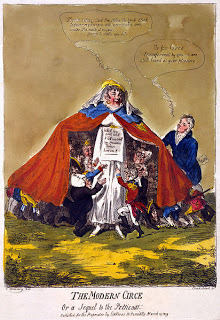
Nevertheless, the charge was sensational, leading to not one but three trials from 1809 to 1813. The first one was the major trial; the subsequent ones were libel suits brought against Mary Anne Clarke and some pamphleteers. Eight specific – and serious -- cases of selling commissions were brought out in the 1809 trial, and are examined minutely in the AAIM, for those who want the sordid (and fascinating) details, but, briefly, it came down to Mary Anne Clarke letting it be known that she would use her influence over the duke to secure commissions and preferments, whether deserved by the petitioners or not, and if this was done with the full knowledge and/or encouragement of the Duke of York. The prices for her intervention into this Army business ranged from £2,600 for promotion to Major to £400 for a mere Ensign. (In the drawing above of the Bishop and his Clarke, the army lists are shown pinned to the almost-conjugal bed shared by Frederick and Mary Anne.) The caricaturists had a field day!
As noted in the caption above, Prince Frederick was forced to resign as Commander-in-Chief of the Army owing to the scandal, but he was reinstated shortly after he was found to be innocent of all the charges brought against him. Another widely circulated caricature was this, attributed to C. Williams and showing Mary Anne with the infamous promotion list in her hand standing before the "York Commission Warehouse":
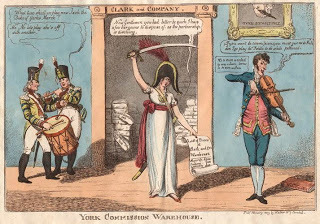 Colored etching, published 1809, shortly after Colonel Wardle had exposed the army commissions scandal in the House of Commons, this satire shows Mrs Clarke with a price list for the sale of commissions. On the right is her intermediary, Domenico Corri, a music master; above him hangs upside down the Duke of York's portrait. Mary Anne is saying that she has bargains for sale but they have to be taken advantage of now because her partnership is dissolving!
Colored etching, published 1809, shortly after Colonel Wardle had exposed the army commissions scandal in the House of Commons, this satire shows Mrs Clarke with a price list for the sale of commissions. On the right is her intermediary, Domenico Corri, a music master; above him hangs upside down the Duke of York's portrait. Mary Anne is saying that she has bargains for sale but they have to be taken advantage of now because her partnership is dissolving!
The manner in which Mary Anne carried on at the trial was said to have been a tour de force worthy of any seasoned stage performance; her quick wit parried and thrust all questions sent her way and impressed spectators. But her reputation – such as it was – was forever ruined. The Duke of York was able to come back; she wasn't. It was not a good thing to be identified from thence forward as a friend of Mary Anne Clarke's; she became a pariah, shunned by the society she in which she'd once played such a large part.
Gillray got into the act, too:
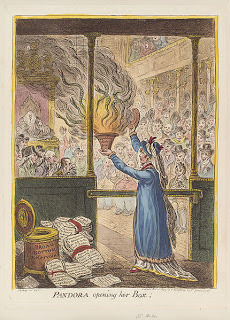
Pandora Opening Her Box, colored aquatint by James Gillray, published by Hannah Humphrey, 1809
After the trial, undaunted, Mary Anne let it be known that she intended to publish Frederick's love letters. Like his brother George in the case of his mistress Mary Robinson, Frederick had been indiscreet. The boys made too many negative remarks about their family members, the royal family. Sir Herbert Taylor was engaged to enter into negotiations with Mary Anne's lawyers for the purchase of the letters and the destruction of all other papers still in her hands.
Mary Anne received an enormous annuity – on top of an immediate £7,000 cash settlement -- her son George's schooling and subsequent Army commission was paid for, and the annuity would pass on to Ellen Clarke, Mary Anne's daughter, at her death. (Similar to the arrangement with Mary Robinson and the Prince of Wales, but Mary and her daughter got nothing in comparison with the monies paid out to Mary Anne Clarke.)
The terms of the annuity also insisted that Mary Anne quit England and reside on the Continent. She was not to publish anything about the royal family, nor was she to say anything that could be deemed disrespectful about them. Though, much later, she once attempted to break the terms of the arrangement, having been approached by a publisher who promised her many thousands of pounds, her lawyers persuaded her to keep the fat bird in her hand rather than seek ephemeral birds in the bush.
The MP who made the initial allegations against the Duke of York, Colonel Wardle, did bring suit against Mary Anne and two pamphleteers for libel – her name was attached to one of the pamphlets – but they were all acquitted. In 1813, however, Mary Anne again went too far and was once again sued, this time for libel of a powerful politician; she was unable to talk her way out of the predicament – the evidence was too strong against her – and she was convicted, spending nine months in prison, supposedly in solitary confinement.
Part Four Coming Soon!

'The York-minuet' (Frederica Charlotte Ulrica Catherina, Duchess of York; Frederick, Duke of York and Albany) by James Gillray (1791)
The prince was married. He was the first of King George II's children to get married. He'd wed his cousin, Princess Frederica of Prussia, a woman noted for her extremely tiny feet, in 1791. Frederica was petite, very short, not at all attractive, and said to have bad teeth. The duke was no prize himself, described as "a giant of a man…with [a] great bluff red face…bulging eyes…ponderous belly [and a] prominent nose." Even more detailed is this from another source: "a red, blotched face…a great paunch…a purple, bulbous nose".
Though Frederica, known as Freddie, was lively, praised for her "neatness", and considered to be a sensible woman, the couple did not mesh and the marriage was not a success. They lived apart, she at Oatlands Park in Surrey, with eighteen dogs; she had many friends, among them the famous Beau Brummell. (Romance novelist Rosemary Stevens, a few years back, played with Freddie and the Beau's relationship in a series of mysteries with Brummell as a kind of Regency Sherlock Holmes. Check them out, they're fun to read!)
At Gloucester Place, Mary Anne Clarke was said to have eaten off exquisite china plates that once belonged to the family of the Duc de Bern, and to drink from crystal wine glasses that had cost upwards of "two guineas a-piece." (A guinea is a pound plus a shilling.) How much did all this cost to maintain? Mary Anne was never one to stay within a budget, as her past so well illustrates. Her talent – or one of them, at any rate – lay in extravagance.
According to Mary Anne, she received from £1,000 to £1,200 annually from the Duke of York, in monthly allotments, for the maintenance of this enormous household. (Bear in mind that, at that time, one pound was worth seventy to eighty times what it is worth today.) This is at odds with the statement of the Chancellor of the Exchequer at the 1809 trial that she was actually paid £6,000 yearly. Mary Anne countered that her payments from the Duke were irregularly doled out. (It is interesting to note here that the royal brothers received many complaints from their ladybirds over the years that payments were not always forthcoming; this has been documented by the experiences of Mary Robinson and Grace Dalrymple Elliott, among others.)
So, to supplement her income, the avaricious, luxury-loving Mary Anne Clarke hit upon a scheme. She would take the lists of army men up for promotions that were sent to her lover and add the names of soldiers who would pay her for the surreptitious promotions. Only a few each time, added at the very end of the lists to which she was privy, thanks to Frederick -- who carelessly kept them lying around -- so as not to arouse suspicion. But she got much too greedy…and she was caught. By 1809, the jig was up.

The Bishop And His Clarke Or A Peep Into Paradise… The Duke of York, Commander-in-Chief of the army (and titular Bishop of Osnabruck, as per this reference) being solicited by Mary Anne Clarke to obtain promotions for her paying clients and friends. The caricature is by Rowlandson, printed by Tegg, 1809.
In January 1809, a little-known Welsh MP, Colonel Gwyllym Lloyd Wardle, alleged in the House of Commons that Frederick, as Duke of York -- the "spare" after his brother the heir to the throne -- and Commander-in-Chief of the Army, "had sanctioned, facilitated, and personally profited from the illicit trafficking in army commissions that his former mistress, Mary Anne Clarke, had engaged in while under his 'protection'." (The Duke of York Affair, Philip Harling, The Historical Journal, 39, 4 (1996), page 963.)
Captain Gronow, in his gossipy memoirs, states that Wardle got wind of Mary Anne's dealings owing to becoming "intimately acquainted with her… [and was] so great a personal favourite that …he wormed out all her secret history, of which he availed himself to obtain a fleeting popularity." Interesting, but, as with anything Gronow says, one has to have the salt shaker handy.
The modern Circe or a sequel to the petticoat", caricature of Mary Anne Clarke by Isaac Cruikshank, 15 March 1809. Her lover Frederick, Duke of York resigned from his post at the head of the British Army ten days after the caricature's publication.

Nevertheless, the charge was sensational, leading to not one but three trials from 1809 to 1813. The first one was the major trial; the subsequent ones were libel suits brought against Mary Anne Clarke and some pamphleteers. Eight specific – and serious -- cases of selling commissions were brought out in the 1809 trial, and are examined minutely in the AAIM, for those who want the sordid (and fascinating) details, but, briefly, it came down to Mary Anne Clarke letting it be known that she would use her influence over the duke to secure commissions and preferments, whether deserved by the petitioners or not, and if this was done with the full knowledge and/or encouragement of the Duke of York. The prices for her intervention into this Army business ranged from £2,600 for promotion to Major to £400 for a mere Ensign. (In the drawing above of the Bishop and his Clarke, the army lists are shown pinned to the almost-conjugal bed shared by Frederick and Mary Anne.) The caricaturists had a field day!
As noted in the caption above, Prince Frederick was forced to resign as Commander-in-Chief of the Army owing to the scandal, but he was reinstated shortly after he was found to be innocent of all the charges brought against him. Another widely circulated caricature was this, attributed to C. Williams and showing Mary Anne with the infamous promotion list in her hand standing before the "York Commission Warehouse":
 Colored etching, published 1809, shortly after Colonel Wardle had exposed the army commissions scandal in the House of Commons, this satire shows Mrs Clarke with a price list for the sale of commissions. On the right is her intermediary, Domenico Corri, a music master; above him hangs upside down the Duke of York's portrait. Mary Anne is saying that she has bargains for sale but they have to be taken advantage of now because her partnership is dissolving!
Colored etching, published 1809, shortly after Colonel Wardle had exposed the army commissions scandal in the House of Commons, this satire shows Mrs Clarke with a price list for the sale of commissions. On the right is her intermediary, Domenico Corri, a music master; above him hangs upside down the Duke of York's portrait. Mary Anne is saying that she has bargains for sale but they have to be taken advantage of now because her partnership is dissolving!The manner in which Mary Anne carried on at the trial was said to have been a tour de force worthy of any seasoned stage performance; her quick wit parried and thrust all questions sent her way and impressed spectators. But her reputation – such as it was – was forever ruined. The Duke of York was able to come back; she wasn't. It was not a good thing to be identified from thence forward as a friend of Mary Anne Clarke's; she became a pariah, shunned by the society she in which she'd once played such a large part.
Gillray got into the act, too:

Pandora Opening Her Box, colored aquatint by James Gillray, published by Hannah Humphrey, 1809
After the trial, undaunted, Mary Anne let it be known that she intended to publish Frederick's love letters. Like his brother George in the case of his mistress Mary Robinson, Frederick had been indiscreet. The boys made too many negative remarks about their family members, the royal family. Sir Herbert Taylor was engaged to enter into negotiations with Mary Anne's lawyers for the purchase of the letters and the destruction of all other papers still in her hands.
Mary Anne received an enormous annuity – on top of an immediate £7,000 cash settlement -- her son George's schooling and subsequent Army commission was paid for, and the annuity would pass on to Ellen Clarke, Mary Anne's daughter, at her death. (Similar to the arrangement with Mary Robinson and the Prince of Wales, but Mary and her daughter got nothing in comparison with the monies paid out to Mary Anne Clarke.)
The terms of the annuity also insisted that Mary Anne quit England and reside on the Continent. She was not to publish anything about the royal family, nor was she to say anything that could be deemed disrespectful about them. Though, much later, she once attempted to break the terms of the arrangement, having been approached by a publisher who promised her many thousands of pounds, her lawyers persuaded her to keep the fat bird in her hand rather than seek ephemeral birds in the bush.
The MP who made the initial allegations against the Duke of York, Colonel Wardle, did bring suit against Mary Anne and two pamphleteers for libel – her name was attached to one of the pamphlets – but they were all acquitted. In 1813, however, Mary Anne again went too far and was once again sued, this time for libel of a powerful politician; she was unable to talk her way out of the predicament – the evidence was too strong against her – and she was convicted, spending nine months in prison, supposedly in solitary confinement.
Part Four Coming Soon!
Published on October 26, 2010 02:51
October 25, 2010
The Wellington Connection: The Charge of the Light Brigade
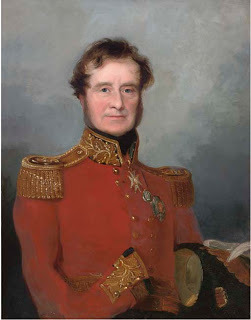 The Duke of Wellington is connected to the Charge of the Light Brigade through his association with Lord Fitzroy Somerset (at left), who was both his military secretary and his nephew by marriage.
The Duke of Wellington is connected to the Charge of the Light Brigade through his association with Lord Fitzroy Somerset (at left), who was both his military secretary and his nephew by marriage. Field Marshal FitzRoy James Henry Somerset, Baron Raglan (1788 - 1855), was a British soldier who distinguished himself particularly in the Spanish parts of the Napoleonic campaign. He was badly wounded by five stab wounds to the shoulder at the Battle of Buçaco, after Fuentes de Onoro became brevet-major, as a volunteer helped storm Ciudad Rodrigo, and subsequently led the storming of Badajoz, and personally secured and quickly held one of the gates before the French could respond.
He was the eighth and youngest son of Henry Somerset, 5th Duke of Beaufort, by Elizabeth, daughter of Admiral the Hon. Edward Boscawen. His elder brother, General Lord Edward Somerset (1776–1842), distinguished himself as the leader of the Household Cavalry brigade at the Battle of Waterloo. Fitzroy Somerset was commissioned onto the 4th Light Dragoons on 9 June 1804, being promoted to Lieutenant on 30 May 1805. In 1807 he was attached to the Hon. Sir Arthur Paget's (later Marquess of Angelsey) embassy to Turkey, and the same year he was selected to serve on the staff of Sir Arthur Wellesley in the expedition to Copenhagen. In the following year he accompanied Wellesley to Portugal, and during the whole of the Peninsular War was at his right hand, first as aide-de-camp and then as military secretary. Lord Hardinge later remarked that he had first become acquainted with Lord FitzRoy Somerset at the battle of Vimiera, "when we of the same age were astonished at the admirable manner in which he then performed the duties of aide-de-camp, and at the great respect with which he was treated by Sir Arthur Wellesley. It was remarked on all occasions that if there was a word of advice to which that great man would listen with unusual patience, it was that which proceeded from Lord FitzRoy Somerset. During the whole period that the Duke of Wellington was in the Peninsula—with the exception, I believe, of a short time when he was in England for the benefit of his health—Lord FitzRoy Somerset was at his right hand. He was present at every one of those actions which illustrate the career of our great commander; on every occasion he was foremost in the field, and he displayed the same valour and courage which have so conspicuously marked bis conduct in the Crimea."
On 6 August 1814 he married Lady Emily Harriet Wellesley-Pole, daughter of the 3rd Earl of Mornington, the Duke of Wellington's niece. As Lady Shelley tells us, "On August 5, 1814, the Duke dined with his regiment at Windsor, and on the following morning returned to town to be present at Emily Pole's marriage with Lord Fitzroy Somerset. While passing through Brentford the wheel of his carriage came off twice. The Duke immediately sprang into a market cart, in full costume as he was, and arrived at the church only a few minutes after the time fixed for the wedding. He gave the bride away, and then dressed for the opera. I met him there, and he took care of me to the carriage."
Between the Napoleonic campaigns, Lord Somerset was secretary to the British embassy at Paris and when Napoleon returned to France he once more became aide-de-camp and military secretary to the Duke of Wellington. At Waterloo his arm was injured and amputated. At the end of the surgery he told orderly not to take away his arm until he had removed a ring that his wife had given him. He quickly learned to write with his left hand, and on the conclusion of the war resumed his duties in Paris.Wellington recommended him as the aide-de-camp to the Prince Regent, a post that was given on 28 August 1815 together with the rank of Colonel. Raglan returned to the British embassy at Paris and remained there as secretary until the end of 1818 when the allied armies were withdrawn from France. For two short periods in the 1820s he was MP for Truro. In 1819 he was appointed secretary to the Duke of Wellington when Wellington became Commander-in-Chief of the army after the Duke of York died on 22 January 1827 and from 1827 till the death of the duke in 1852, Somerset served as his Military Secretary at the Horse Guards. Wellington described him as 'a man who wouldn't tell a lie to save his life'.
Somerset's political career culminated in his being appointed a Privy Counsellor in 1852, when he was created Baron Raglan.
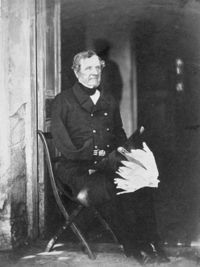 At the outbreak of the Crimean War in 1853, Raglan was chosen to command the British troops, despite the fact that he was sixty-five years old and had never led troops in the field. He left London on 10 April and reached Constantinople at the end of the month. In 1854, Raglan (at left) was made full General and joint commander of the Crimean campaign in co-operation with a strong French army under Marshal St. Arnaud and afterwards, up to May 1855, under Marshal Canrobert. Here his diplomatic experience stood him in good stead in dealing with the generals and admirals, British, French and Turkish, who were associated with him; however, the trying winter campaign of the Crimean War showed that becoming a General was a step too far for Raglan. His failure to give coherent or timely commands on the field of battle led to numerous mistakes, and his blind ignorance of the growing rivalry between the Earl of Lucan and the Earl of Cardigan would have tragic consequences in the infamous Charge of the Light Brigade.
At the outbreak of the Crimean War in 1853, Raglan was chosen to command the British troops, despite the fact that he was sixty-five years old and had never led troops in the field. He left London on 10 April and reached Constantinople at the end of the month. In 1854, Raglan (at left) was made full General and joint commander of the Crimean campaign in co-operation with a strong French army under Marshal St. Arnaud and afterwards, up to May 1855, under Marshal Canrobert. Here his diplomatic experience stood him in good stead in dealing with the generals and admirals, British, French and Turkish, who were associated with him; however, the trying winter campaign of the Crimean War showed that becoming a General was a step too far for Raglan. His failure to give coherent or timely commands on the field of battle led to numerous mistakes, and his blind ignorance of the growing rivalry between the Earl of Lucan and the Earl of Cardigan would have tragic consequences in the infamous Charge of the Light Brigade.The Charge of the Light Brigade was a disastrous charge of British cavalry led by Lord Cardigan against Russian forces on 25 October, 1854 during the Battle of Balaclava in the Crimean War. Subsequently Raglan was pilloried by the press, rightly or wrongly, for the conditions which led to so many troops being unfit to serve, falling seriously ill or dying, and being responsible for the incompetent chain of command and poor tactics which led to Inkerman and then the Charge of the Light Brigade. To be fair, much of the responsibility must fall on authorities in the UK, and appalling logistics from there.
Today, the incident is best remembered as the subject of a famous poem entitled The Charge of the Light Brigade by Alfred, Lord Tennyson, whose lines have made the charge a symbol of warfare at both its most courageous and its most tragic.
Half a league, half a league,
Half a league onward,
All in the valley of Death
Rode the six hundred.
'Forward, the Light Brigade!
Charge for the guns' he said:
Into the valley of Death
Rode the six hundred.
Oddly enough, despite Raglan's military unpopularity, he was put in charge of the general assault on Sebastapol on 18 June 1855 - the anniversary of the Battle of Waterloo. It was to be preceded by a two-hour cannonade but the French commander decided at the last moment to attack at daybreak, a decision that Raglan reluctantly accepted. The result was disastrous. The French columns were driven back with heavy loss. Raglan ordered the British forward against the Redan where the two leading British columns met a murderous fire of grapeshot and musket fire. Raglan felt responsible for the failure. He was already suffering from dysentery and on the evening of 28 June he died. His body was taken to the Caradoc with the full military honours: the seven miles of road from his headquarters to Kazatch Bay was lined with troops. The ship reached Bristol on 24 July; Raglan was buried privately at Badminton on the 26 July.
Published on October 25, 2010 03:55
October 24, 2010
Mary Anne Clark by Jo Manning - Part Two
Mary Anne Clarke was a beautiful woman. Not all courtesans were beautiful – some relied on wit more than beauty -- but she was amongst the beauties. Her features – the wealth of soft, dark, curly hair, the changeable eyes (probably hazel), tip-tilted nose, red lips, dimpled chin, the superb white neck and shoulders and a full bosom -- were admirably painted in the miniature on ivory by Adam Buck at the beginning of this piece. Her figure was petite, her feet tiny, and her smile (and laugh) as described by her great-great-grand-daughter, above, infectious and memorable. She was also said to be intelligent and quick-witted, known for her skill at repartee and the sharpness of her remarks.
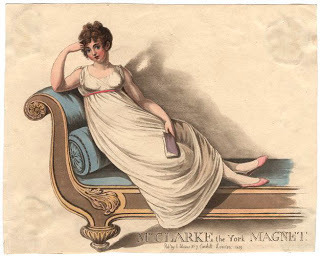
"Mrs Clarke the York Magnet", hand-colored aquatint by unknown artist, published 1809
But she was a vulgar piece of work, this girl from the mean streets of London, often coarse in language and behavior, impudent, provocative, feisty, tough, possessing a "gutter loveliness," Du Maurier noted, that was perhaps all "the more alluring because it was ill-bred." Those not taken in by her smile described her as being "an actress…completely unscrupulous in every way."
From the 1809 source Authentic And Interesting Memoirs of Mrs Clarke, From Her Infamy To The Present Time, Likewise A Brief Account of Mr Wardle's Charges Relative To His Royal Highness The Duke of York: Together With The Minutes of Evidence As Taken In The House Of Commons From Authentic Documents… anonymously published in England (and abroad), there is much biographical information…most of it dubious. (I will abbreviate this source as AAIM.) The unverifiable nature of most of this material, however, has not kept it from being repeated as fact in articles relating to the life of Mary Anne Clarke.
From the AAIM, we are told that she was born circa 1776, in an area of London called Ball-and-Pin Alley, near White's Alley, Chancery Lane (it's sometimes cited as Bowling Inn Alley or Bowling Pin Alley). It was a humble upbringing, to be sure, a place of ill-kept and dirty lodging-houses, where poverty reigned. Her maiden name is given as Thompson, and we are told that her father was a tradesman who died when she was young. There was a stepfather named Farquhar who's described as a compositor/corrector at a print-shop owned by a Mr. Hughs in Fleet Street.
The narrative of this so-called memoir relates that Mary Anne would go daily to the print-shop to collect her stepfather's work, and that she'd undertake the necessary correcting, thus becoming the mainstay of her struggling family. This assumes, of course, that she'd been taught to read and write – and did both well -- before she took this upon herself. The narrative goes on to say that a Mr. Day, the overseer of the print-shop -- attracted by her vivacity and charm, no doubt -- sends her to a school at Ham, in Essex, to be educated. His motive, we are told, is that he had "a view of making her his wife at some future period," but when she returns, after supposedly spending two years in Ham, things do not work out for Mr. Day. Wedding off! (And, really, it is hard to believe this sending-away-to-school scenario ever happened.)
At this juncture, the Thompson/Farquhar family moves to Black Raven Passage, Cursitor-street, in Holborn, and the narrative goes on to tell of her dealings with a pawnbroker, a Mr F—ll--d, who gives her exorbitant sums of money, to the extent that she eventually ruins him and his business. Undaunted, Mary Anne then sets her sights on another man, Joseph Clarke, the second son of a wealthy bricklayer in Angel-Court, Snowhill, with whom she elopes to Pentonville. She is probably about seventeen years old; they supposedly married in 1794. Clarke's father sets him up in a business, a stone yard in Golden-lane. (Captain Gronow, in his memoirs, says that Clarke was "a captain in a marching regiment" which has no substantiation whatsoever; Gronow's memoirs are a wealth of information on the Regency period, but he is often careless with his facts.)
In two years, however, Joseph Clarke is bankrupt and there are tales of philandering ("amours"), and that he is "careless and drunken." There is no money, but there are, according to the narrative, four children, which is at odds with everything else I have seen that says Mary Anne only had two children, George and Ellen, with Clarke. (A recent article by a writer who was comparing Fergie, the divorced Duchess of York, to Mary Anne Clark – an interesting comparison, but one that can go only so far -- stated there were three children. George and Ellen, however, are the only two names that come up consistently. I've never seen a reference to a third or fourth child.)
And – are you ready for this? -- now we have Mary Anne on the stage, supposedly playing a Shakespearian role, Portia (!), in The Merchant Of Venice, at the Haymarket Theatre. That is extremely hard to believe! There are some asides to her as an actress, character-wise, but verifying that she was indeed on stage – and in a leading role, yet -- is problematic. (It should be kept in mind, too, that many streetwalkers and courtesans falsely claimed to be actresses.)
What's more likely is that she took to the streets after breaking up with Clarke. She had to support her children, after all. Below is a cartoon that speculates on this premise. This contemporary cartoon I saw had what appeared to be penciled in scribbling that might be "M--- A---? Clarke"; it shows an ugly old bawd sending a beautiful young streetwalker (who doesn't look all that much like Mary Anne), out to work; it is undated but bears the caption, Launching A Frigate.
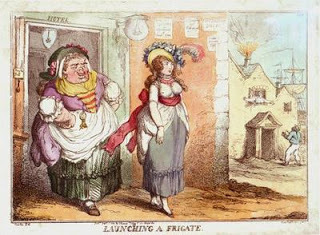 Image is by Rowlandson
Image is by Rowlandson
So, while any career on the streets is difficult to confirm, what is known is that she soon climbed up the well-trodden whore's ladder and began to consort with eminent and wealthy men. Among the men named in the AAIM narrative are: Sir Charles M—ln—r; Sir James B.; and an army agent, a Mr. O.; a ne'er do well from Bayswater who'd supposedly seen her on stage, Mr. M—l—y; and a high-roller named Mr. Dowler who takes her to Brighton. The dates don't add up at all, but this bit is priceless:
"At Brighton under the protection of Mr. Dowler, it is said that she distinguished herself as an excellent swimmer, and occasionally to float on the liquid element to the great astonishment and admiration of the spectators."
The bathing beauty dumps Mr. Dowler – no doubt after bankrupting him, too – and flees to London with Mr. O – now referred to as Mr. O—l—e, the army agent. They set up house in Tavistock Place. Again, the dates don't make sense, because the attachments mentioned are all up to 1808, and by 1803/4, she'd already met the Duke of York.
The house below is said to be where she was living before meeting Prince Frederick; it is not Tavistock Place. It's Chester House, formerly called Manchester House, in Exmouth. The lack of verifiable facts abound, as can be seen in the blue plaque put up on the house by the local historical society:
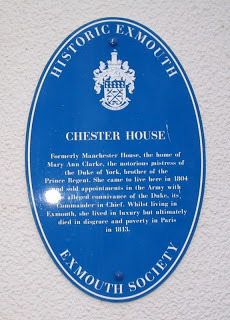
The blue plaque can be seen to the right of the front door. Note that it is not one of the famous – and usually a bit more accurate! -- blue plaques put up by English Heritage. This one states that Mary Anne Clarke "died in disgrace and poverty in Paris in 1813." Au contraire, as we shall see, for she died in her dotage -- quite well off, despite her many extravagances -- in Boulogne, in 1852 or 1853. (Daphne Du Maurier, despite having cited the use of three researchers, has her death date one way in The Du Mauriers and the other way in Mary Anne. In the recent Christine Hand article contrasting Sarah Ferguson, Duchess of York to Mary Anne, gives the latter's date of death as 1882, which would have made her 106! She was actually about seventy-six.)
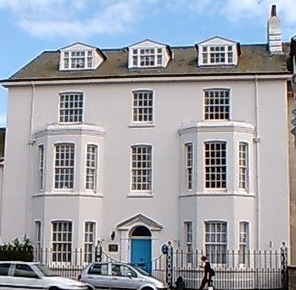
Chester House (Manchester House) with the blue plaque at the side of the front door
So, circa 1803/1804, Mary Anne Clarke, after quite a whirl with quite a large number of men, begins a relationship with Prince Frederick, Duke of York, the brother of Prince George (later King George IV), the Prince of Wales. Frederick was the Commander-in-Chief of the British Army, hence the nursery rhyme of "the grand old Duke of York" (The origins of this ditty actually pre-dated this particular Duke of York, possibly going back to the 14th century, but it has been associated solely with him in recent memory.)
The undated print below shows the two princely sibs with their father, the king.
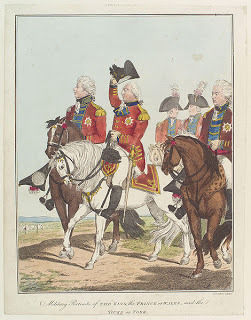
Part Three Coming Soon!

"Mrs Clarke the York Magnet", hand-colored aquatint by unknown artist, published 1809
But she was a vulgar piece of work, this girl from the mean streets of London, often coarse in language and behavior, impudent, provocative, feisty, tough, possessing a "gutter loveliness," Du Maurier noted, that was perhaps all "the more alluring because it was ill-bred." Those not taken in by her smile described her as being "an actress…completely unscrupulous in every way."
From the 1809 source Authentic And Interesting Memoirs of Mrs Clarke, From Her Infamy To The Present Time, Likewise A Brief Account of Mr Wardle's Charges Relative To His Royal Highness The Duke of York: Together With The Minutes of Evidence As Taken In The House Of Commons From Authentic Documents… anonymously published in England (and abroad), there is much biographical information…most of it dubious. (I will abbreviate this source as AAIM.) The unverifiable nature of most of this material, however, has not kept it from being repeated as fact in articles relating to the life of Mary Anne Clarke.
From the AAIM, we are told that she was born circa 1776, in an area of London called Ball-and-Pin Alley, near White's Alley, Chancery Lane (it's sometimes cited as Bowling Inn Alley or Bowling Pin Alley). It was a humble upbringing, to be sure, a place of ill-kept and dirty lodging-houses, where poverty reigned. Her maiden name is given as Thompson, and we are told that her father was a tradesman who died when she was young. There was a stepfather named Farquhar who's described as a compositor/corrector at a print-shop owned by a Mr. Hughs in Fleet Street.
The narrative of this so-called memoir relates that Mary Anne would go daily to the print-shop to collect her stepfather's work, and that she'd undertake the necessary correcting, thus becoming the mainstay of her struggling family. This assumes, of course, that she'd been taught to read and write – and did both well -- before she took this upon herself. The narrative goes on to say that a Mr. Day, the overseer of the print-shop -- attracted by her vivacity and charm, no doubt -- sends her to a school at Ham, in Essex, to be educated. His motive, we are told, is that he had "a view of making her his wife at some future period," but when she returns, after supposedly spending two years in Ham, things do not work out for Mr. Day. Wedding off! (And, really, it is hard to believe this sending-away-to-school scenario ever happened.)
At this juncture, the Thompson/Farquhar family moves to Black Raven Passage, Cursitor-street, in Holborn, and the narrative goes on to tell of her dealings with a pawnbroker, a Mr F—ll--d, who gives her exorbitant sums of money, to the extent that she eventually ruins him and his business. Undaunted, Mary Anne then sets her sights on another man, Joseph Clarke, the second son of a wealthy bricklayer in Angel-Court, Snowhill, with whom she elopes to Pentonville. She is probably about seventeen years old; they supposedly married in 1794. Clarke's father sets him up in a business, a stone yard in Golden-lane. (Captain Gronow, in his memoirs, says that Clarke was "a captain in a marching regiment" which has no substantiation whatsoever; Gronow's memoirs are a wealth of information on the Regency period, but he is often careless with his facts.)
In two years, however, Joseph Clarke is bankrupt and there are tales of philandering ("amours"), and that he is "careless and drunken." There is no money, but there are, according to the narrative, four children, which is at odds with everything else I have seen that says Mary Anne only had two children, George and Ellen, with Clarke. (A recent article by a writer who was comparing Fergie, the divorced Duchess of York, to Mary Anne Clark – an interesting comparison, but one that can go only so far -- stated there were three children. George and Ellen, however, are the only two names that come up consistently. I've never seen a reference to a third or fourth child.)
And – are you ready for this? -- now we have Mary Anne on the stage, supposedly playing a Shakespearian role, Portia (!), in The Merchant Of Venice, at the Haymarket Theatre. That is extremely hard to believe! There are some asides to her as an actress, character-wise, but verifying that she was indeed on stage – and in a leading role, yet -- is problematic. (It should be kept in mind, too, that many streetwalkers and courtesans falsely claimed to be actresses.)
What's more likely is that she took to the streets after breaking up with Clarke. She had to support her children, after all. Below is a cartoon that speculates on this premise. This contemporary cartoon I saw had what appeared to be penciled in scribbling that might be "M--- A---? Clarke"; it shows an ugly old bawd sending a beautiful young streetwalker (who doesn't look all that much like Mary Anne), out to work; it is undated but bears the caption, Launching A Frigate.
 Image is by Rowlandson
Image is by RowlandsonSo, while any career on the streets is difficult to confirm, what is known is that she soon climbed up the well-trodden whore's ladder and began to consort with eminent and wealthy men. Among the men named in the AAIM narrative are: Sir Charles M—ln—r; Sir James B.; and an army agent, a Mr. O.; a ne'er do well from Bayswater who'd supposedly seen her on stage, Mr. M—l—y; and a high-roller named Mr. Dowler who takes her to Brighton. The dates don't add up at all, but this bit is priceless:
"At Brighton under the protection of Mr. Dowler, it is said that she distinguished herself as an excellent swimmer, and occasionally to float on the liquid element to the great astonishment and admiration of the spectators."
The bathing beauty dumps Mr. Dowler – no doubt after bankrupting him, too – and flees to London with Mr. O – now referred to as Mr. O—l—e, the army agent. They set up house in Tavistock Place. Again, the dates don't make sense, because the attachments mentioned are all up to 1808, and by 1803/4, she'd already met the Duke of York.
The house below is said to be where she was living before meeting Prince Frederick; it is not Tavistock Place. It's Chester House, formerly called Manchester House, in Exmouth. The lack of verifiable facts abound, as can be seen in the blue plaque put up on the house by the local historical society:

The blue plaque can be seen to the right of the front door. Note that it is not one of the famous – and usually a bit more accurate! -- blue plaques put up by English Heritage. This one states that Mary Anne Clarke "died in disgrace and poverty in Paris in 1813." Au contraire, as we shall see, for she died in her dotage -- quite well off, despite her many extravagances -- in Boulogne, in 1852 or 1853. (Daphne Du Maurier, despite having cited the use of three researchers, has her death date one way in The Du Mauriers and the other way in Mary Anne. In the recent Christine Hand article contrasting Sarah Ferguson, Duchess of York to Mary Anne, gives the latter's date of death as 1882, which would have made her 106! She was actually about seventy-six.)

Chester House (Manchester House) with the blue plaque at the side of the front door
So, circa 1803/1804, Mary Anne Clarke, after quite a whirl with quite a large number of men, begins a relationship with Prince Frederick, Duke of York, the brother of Prince George (later King George IV), the Prince of Wales. Frederick was the Commander-in-Chief of the British Army, hence the nursery rhyme of "the grand old Duke of York" (The origins of this ditty actually pre-dated this particular Duke of York, possibly going back to the 14th century, but it has been associated solely with him in recent memory.)
The undated print below shows the two princely sibs with their father, the king.

Part Three Coming Soon!
Published on October 24, 2010 02:38
October 23, 2010
The King's Speech
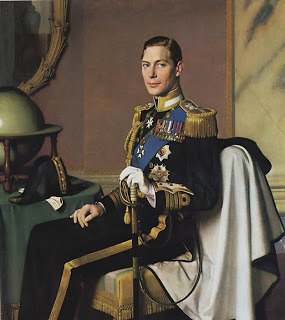
Colin Firth will be playing King George VI in a new film called The King's Speech. Set to open in November, Geoffrey Rush plays royal speech therapist Lionel Logue, while Helena Bonham Carter will play the Queen Mum.


The King's Speech tells the story of the man who would become King George VI, the father of the current Queen, Elizabeth II. After his brother abdicates, George 'Bertie' VI (Firth) reluctantly assumes the throne. Plagued by a dreaded nervous stammer and considered unfit to be King, Bertie engages the help of an unorthodox speech therapist named Lionel Logue (Rush). Through a set of unexpected techniques, and as a result of an unlikely friendship, Bertie is able to find his voice and boldly lead the country into war.
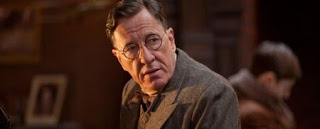
A handsome and rather shy younger son, George VI came to the throne after his brother, Edward VIII, abdicated the throne of England in order to marry Mrs. Simpson. George and Lady Elizabeth Bowes-Lyon were married in 1923 and had two daughters, Queen Elizabeth II and Princess Margaret. The Queen Consort never forgave Edward VIII for his selfish action in abdicating, thus throwing the responsibility for the country upon her husband, whose health had never been the best. Within three three years of his accession, King George VI found himself at the head of a country at war with Nazi Germany. Choosing to stay at Buckingham Palace in London through the worst of the bombing, the King and Queen garnered themselves legion of loyal subjects who praised them for their courage and for their selflessness in helping at air raid shelters and bomb sites and by standing fast through the blitz.
Charles, Prince of Wales, recently hosted a reception at Clarence House, his London home, to celebrate the work of the country's only national stammering centre, The Michael Palin Centre for Stammering Children in Islington, north London. Speaking about George VI the Prince told his guests ''His stammer cut him off I think in so many ways from his parents and his brothers and sisters and drove him into himself as I suspect so many stammerers will understand. I think above all he experienced that awful fear of feeling different from others.''
The Prince joked with the audience about how the Monarch's speech problem would be dealt with in the forthcoming film about his grandfather: "My grandfather was fortunate enough to receive speech therapist services which enabled him to overcome the condition."
The Palin Centre was founded in 1993 and the comic actor and travel presenter agreed to the institution being named after him following his role as a stammering character called Ken in the hit movie A Fish Called Wanda.
You can watch an interview with Mr. Firth about his upcoming role here.
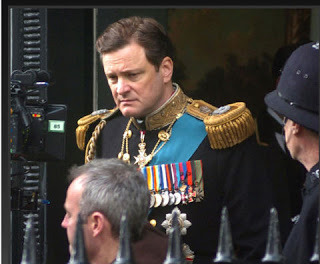
Published on October 23, 2010 02:17
October 22, 2010
Mary Anne Clarke by Jo Manning - Part One
"Mary Anne, Mary Anne,Cook the slut in a frying-pan"
--- Sung in the streets of London following the fall from grace of the courtesan Mary Anne Clarke
***
The Grand old Duke of York he had ten thousand men
He marched them up to the top of the hill
And he marched them down again.
When they were up, they were up
And when they were down, they were down
And when they were only halfway up
They were neither up nor down
--- Old children's nursery rhyme associated with Prince Frederick, Duke of York, in the early 19th century
***
When I was researching My Lady Scandalous, the biography I was to write of the royal courtesan Grace Dalrymple Elliott, I came across tales of many other royal (and non-royal) courtesans of the era. One of the most colorful and controversial was the mistress of King George III's brother, Prince Frederick Augustus, the grand old Duke of York. Her name was Mary Anne Clarke.
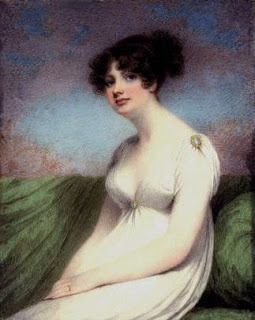 Portrait of Mary Anne Clarke, by Adam Buck, 1803. Though not widely known these days, the Irish-born Buck was an accomplished miniaturist painter and a favorite of the aristocracy. He had a studio in Soho at the time this was painted.What fascinated me was not just that Mary Anne Clarke was involved in one of the major political scandals of the late 18th-early 19th centuries, involving the sale of army commissions for her private gain, but that she was the direct ancestor of the popular novelist Daphne Du Maurier. She was Du Maurier's great-great-grandmother!
Portrait of Mary Anne Clarke, by Adam Buck, 1803. Though not widely known these days, the Irish-born Buck was an accomplished miniaturist painter and a favorite of the aristocracy. He had a studio in Soho at the time this was painted.What fascinated me was not just that Mary Anne Clarke was involved in one of the major political scandals of the late 18th-early 19th centuries, involving the sale of army commissions for her private gain, but that she was the direct ancestor of the popular novelist Daphne Du Maurier. She was Du Maurier's great-great-grandmother!Du Maurier has always been one of my favorite popular writers. The woman was a brilliant storyteller, as evidenced by the remarkable novels Rebecca, My Cousin Rachel, Jamaica Inn, Frenchman's Creek, and the short stories The Birds and Don't Look Back.
All of these have been made into excellent, classic films; my particular favorite the most recent retelling of the uber-romantic Frenchman's Creek, starring Tara Fitzgerald and Anthony Delon. Sorry, I have to digress with this photograph:
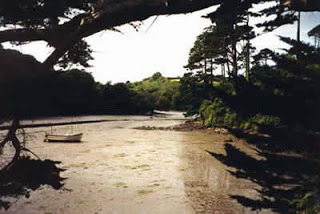
I've been here! The Frenchman's Creek of the book title, on the Helford River, near the town of Helford, Cornwall, at low tide
And who among us can forget the evocative opening line of the suspenseful gothic novel Rebecca: "Last night I dreamed of Manderley again…" as the camera lingers on the ruins of a once-gorgeous mansion shrouded in the flowing mists of sad remembrance and regret. Unforgettable.
But did you know that Daphne Du Maurier also wrote biographies? She wrote a biography of her father, the acclaimed actor-manager Gerald Du Maurier, Gerald: A Portrait, shortly after his death in 1934. Her 1937 family biography, The Du Mauriers, tells the story of a famously talented and eccentric group of actors, novelists, and artists who were descended from Mary Anne Clarke and, on the other side, from the marriage of her daughter Ellen into a family of French émigré glassblowers, the Busson du Mauriers. (She also wrote separately about this French family in The Glass-Blowers, published in 1963.)
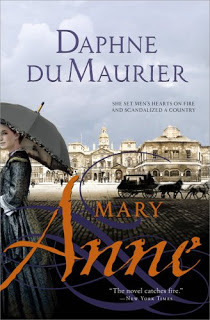
In 1954, the fictionalized biography of Mary Anne Clarke, simply titled Mary Anne, was published. The opening pages of this novel immediately draw the reader into the story. It is good fictional writing at its best. Though the opening below is a long passage, not one word is wasted, and the reader immediately learns all one needs to know about the flamboyant creature Mary Anne Clarke:
"Years later, when she had gone and was no longer part of their lives, the thing they remembered about her was her smile. Coloring and features were indistinct, hazy in memory. The eyes, surely, were blue – but they could have been green or grey. And the hair, knotted in the Grecian fashion piled high on top of the head in curls, might have been chestnut or light brown. The nose was anything but Grecian – that was a certainty, for it pointed to heaven; and the actual shape of the mouth had never seemed important – not at the time, or now.
"The essence of what had been lay in the smile. It began at the left corner of the mouth and hovered momentarily, mocking without discrimination those she loved most – including her own family – and those she despised. And, while they waited uneasily, expexting a blast of sarcasm or the snub direct, the smile spread to the eyes, transfiguring the whole face, lighting it to gaiety. Reprieved, they basked in the warmth and shared the folly, and there was no intellectual pose in the laugh that followed, ribald, riotous, cockney, straight from the belly.
"This was what they remembered in after years. The rest was forgotten. Forgotten the lies, the deceit, the sudden bursts of temper. Forgotten the wild extravagance, the absurd generosity, the vitriolic tongue. Only the warmth remained, and the love of living."
Part Two Coming Soon!
Published on October 22, 2010 02:28
October 21, 2010
Rex Whistler, Imaginative Painter, Romantic Hero...
First, know that English artist Rex Whistler (1905-1944) was no relation at all to American artist James Abbott McNeill Whistler (1834–1903), however amusing it would be to link their work.
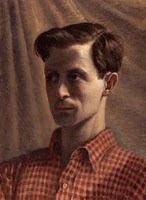 Rex Whistler, self-portrait, 1934
Rex Whistler, self-portrait, 1934
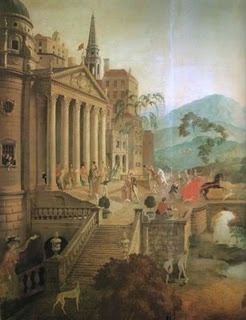 Rex Whistler was born in Kent and showed enormous talent while still in his teens. However, he did not do well in school, nor at the Royal Academy where he was expelled. More successful was his stay at the Slade School of Art where he made friends with the Honourable Stephen Tennant, and later with Tennant's friend poet Siegfried Sassoon.
Rex Whistler was born in Kent and showed enormous talent while still in his teens. However, he did not do well in school, nor at the Royal Academy where he was expelled. More successful was his stay at the Slade School of Art where he made friends with the Honourable Stephen Tennant, and later with Tennant's friend poet Siegfried Sassoon.
While still at Slade, at age 22, he was hired to paint a mural in the basement cafe of the Tate Gallery. He worked with novelist Edith Olivier (1872–1948) on illustrating the story of seven people who search for exotic fare: Expedition in Search of Rare Meats.
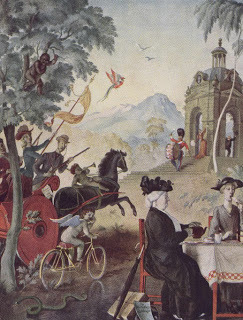
According to the publications of the restaurant, "They leave on bicycles, carts and horses from the 'Duchy of Epicurania', and travel through strange and wonderful lands encountering unicorns, truffle dogs and two giant gluttons guarding the entrance to a cave. The story ends with the travellers returning to a joyful homecoming, and the diet of the people, which had previously consisted of dry biscuits, is transformed."
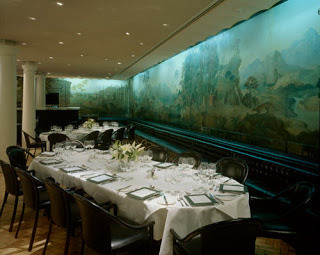 The mural still decorates the restaurant in the Tate Britain, where we have occasionally dined. Once I saw John Malkovich also enjoying the excellent food and renowned wine list. Here is a link to the restaurant.
The mural still decorates the restaurant in the Tate Britain, where we have occasionally dined. Once I saw John Malkovich also enjoying the excellent food and renowned wine list. Here is a link to the restaurant.

Between the world wars, Rex Whistler knew, socialized and painted many of London's social elite, sometimes known as the "Bright Young Things".
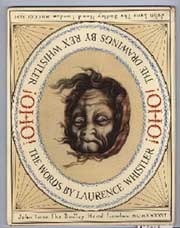 One of the things he is often remembered for, perhaps at the expense of his other achievements, is the set of reversible faces he drew, later incorporated into a book written by his brother and published in 1947.
One of the things he is often remembered for, perhaps at the expense of his other achievements, is the set of reversible faces he drew, later incorporated into a book written by his brother and published in 1947.
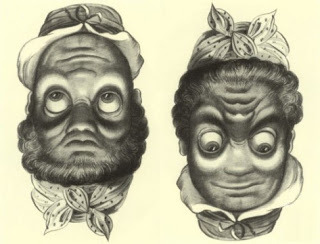 Rex Whistler's reversible faces
Rex Whistler's reversible faces
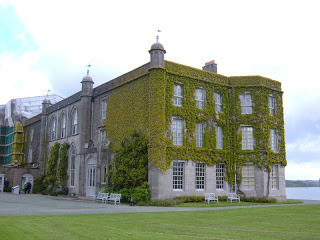 Rex Whistler went on to design more murals, book illustrations, commerical posters, stage designs and scenery, and many other artistic projects. One of the most famous is the mural he painted at Plas Newyyd on the Island of Anglesey in Wales for the Marquess of Anglesey (this house has an interesting history I will write about another time.)
Rex Whistler went on to design more murals, book illustrations, commerical posters, stage designs and scenery, and many other artistic projects. One of the most famous is the mural he painted at Plas Newyyd on the Island of Anglesey in Wales for the Marquess of Anglesey (this house has an interesting history I will write about another time.)
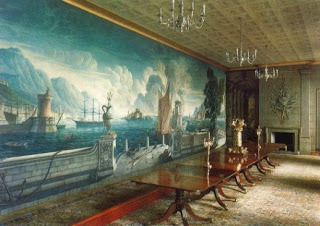 Rex Whistler, one of the "Bright Young Things" who often stayed at Plas Newyyd designed a fanstasy mural for the mansion's dining room. While he was cavorting with this set, he fell in love with Lady Caroline Paget, whom he painted many times.
Rex Whistler, one of the "Bright Young Things" who often stayed at Plas Newyyd designed a fanstasy mural for the mansion's dining room. While he was cavorting with this set, he fell in love with Lady Caroline Paget, whom he painted many times.
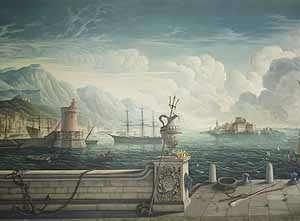 detail
detail
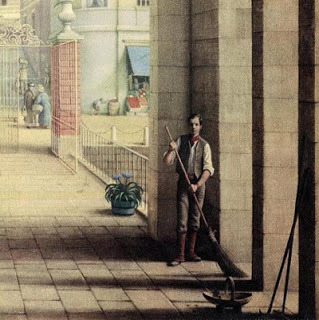 Whistler painted himself into the mural.
Whistler painted himself into the mural.
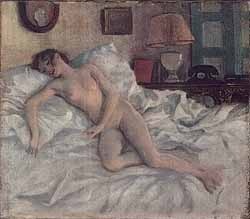 Lady Caroline Paget When war broke out, Rex Whistler joined the Welsh Guards as an officer. He was killed in Normandy in 1944.
Lady Caroline Paget When war broke out, Rex Whistler joined the Welsh Guards as an officer. He was killed in Normandy in 1944.
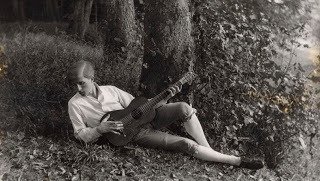 Whistler photographed by Cecil Beaton, 1927Among Whistler's other projects is a room in Montisfort Abbey, in Hampshire, a trompe d'oeil that has enchanted viewers ever since.
Whistler photographed by Cecil Beaton, 1927Among Whistler's other projects is a room in Montisfort Abbey, in Hampshire, a trompe d'oeil that has enchanted viewers ever since.
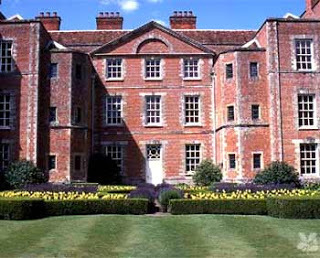 Mottisfont Abbey, Hampshire
Mottisfont Abbey, Hampshire
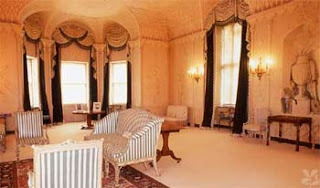 Rex Whistler Room
Rex Whistler Room
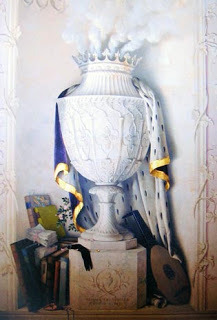 Mottisfont Abbey detail
Mottisfont Abbey detail
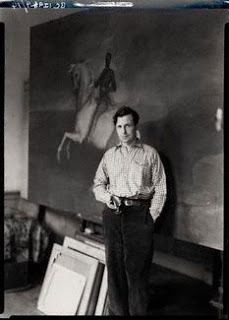 Rex Whistler in 1936
Rex Whistler in 1936

 Rex Whistler, self-portrait, 1934
Rex Whistler, self-portrait, 1934 Rex Whistler was born in Kent and showed enormous talent while still in his teens. However, he did not do well in school, nor at the Royal Academy where he was expelled. More successful was his stay at the Slade School of Art where he made friends with the Honourable Stephen Tennant, and later with Tennant's friend poet Siegfried Sassoon.
Rex Whistler was born in Kent and showed enormous talent while still in his teens. However, he did not do well in school, nor at the Royal Academy where he was expelled. More successful was his stay at the Slade School of Art where he made friends with the Honourable Stephen Tennant, and later with Tennant's friend poet Siegfried Sassoon.While still at Slade, at age 22, he was hired to paint a mural in the basement cafe of the Tate Gallery. He worked with novelist Edith Olivier (1872–1948) on illustrating the story of seven people who search for exotic fare: Expedition in Search of Rare Meats.

According to the publications of the restaurant, "They leave on bicycles, carts and horses from the 'Duchy of Epicurania', and travel through strange and wonderful lands encountering unicorns, truffle dogs and two giant gluttons guarding the entrance to a cave. The story ends with the travellers returning to a joyful homecoming, and the diet of the people, which had previously consisted of dry biscuits, is transformed."
 The mural still decorates the restaurant in the Tate Britain, where we have occasionally dined. Once I saw John Malkovich also enjoying the excellent food and renowned wine list. Here is a link to the restaurant.
The mural still decorates the restaurant in the Tate Britain, where we have occasionally dined. Once I saw John Malkovich also enjoying the excellent food and renowned wine list. Here is a link to the restaurant.
Between the world wars, Rex Whistler knew, socialized and painted many of London's social elite, sometimes known as the "Bright Young Things".
 One of the things he is often remembered for, perhaps at the expense of his other achievements, is the set of reversible faces he drew, later incorporated into a book written by his brother and published in 1947.
One of the things he is often remembered for, perhaps at the expense of his other achievements, is the set of reversible faces he drew, later incorporated into a book written by his brother and published in 1947. Rex Whistler's reversible faces
Rex Whistler's reversible faces Rex Whistler went on to design more murals, book illustrations, commerical posters, stage designs and scenery, and many other artistic projects. One of the most famous is the mural he painted at Plas Newyyd on the Island of Anglesey in Wales for the Marquess of Anglesey (this house has an interesting history I will write about another time.)
Rex Whistler went on to design more murals, book illustrations, commerical posters, stage designs and scenery, and many other artistic projects. One of the most famous is the mural he painted at Plas Newyyd on the Island of Anglesey in Wales for the Marquess of Anglesey (this house has an interesting history I will write about another time.) Rex Whistler, one of the "Bright Young Things" who often stayed at Plas Newyyd designed a fanstasy mural for the mansion's dining room. While he was cavorting with this set, he fell in love with Lady Caroline Paget, whom he painted many times.
Rex Whistler, one of the "Bright Young Things" who often stayed at Plas Newyyd designed a fanstasy mural for the mansion's dining room. While he was cavorting with this set, he fell in love with Lady Caroline Paget, whom he painted many times.
 detail
detail
 Whistler painted himself into the mural.
Whistler painted himself into the mural. Lady Caroline Paget When war broke out, Rex Whistler joined the Welsh Guards as an officer. He was killed in Normandy in 1944.
Lady Caroline Paget When war broke out, Rex Whistler joined the Welsh Guards as an officer. He was killed in Normandy in 1944. Whistler photographed by Cecil Beaton, 1927Among Whistler's other projects is a room in Montisfort Abbey, in Hampshire, a trompe d'oeil that has enchanted viewers ever since.
Whistler photographed by Cecil Beaton, 1927Among Whistler's other projects is a room in Montisfort Abbey, in Hampshire, a trompe d'oeil that has enchanted viewers ever since. Mottisfont Abbey, Hampshire
Mottisfont Abbey, Hampshire
 Rex Whistler Room
Rex Whistler Room
 Mottisfont Abbey detail
Mottisfont Abbey detail Rex Whistler in 1936
Rex Whistler in 1936
Published on October 21, 2010 02:30
October 20, 2010
Thomas Lawrence Exhibition at the National Portrait Gallery
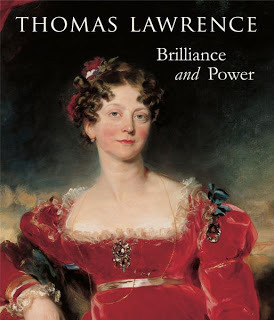 Princess Sophia
Princess SophiaThe National Portrait Gallery in London is staging an exhibition called, "Thomas Lawrence: Regency Power and Brilliance" from 21 October 2010 - 23 January 2011. Thomas Lawrence was the greatest British portrait painter of his generation., and this exhibition, the first to focus on Lawrence's work in the UK for over thirty years, explores his development into the most celebrated and influential artist in Europe at the start of the nineteenth century. Featuring over fifty works, it showcases the artist's greatest paintings and drawings alongside lesser known works, drawn from public and private collections around the world. When it closes in London, the exhhibition will move to the Yale Center for British Art, New Haven, Connecticut from 24 February to 5 June 2011. This will be the first exhibition in the United Kingdom since 1979 to examine Lawrence's work and the first substantial presentation of this artist in the United States. It will present Lawrence as the most important British portrait painter of his generation and will explore his development as one of the most celebrated and influential European artists of the late eighteenth and early nineteenth centuries. By his untimely death in 1830 Lawrence had achieved the greatest international reach and reputation of any British artist.
A new book called Thomas Lawrence: Regency Brilliance and Power has been published in conjunction with the exhibition, edited by Cassandra Albinson, Peter Funnell, and Lucy Peltz, with essays by Cassandra Albinson, Peter Funnell, and Marcia Pointon. This important book explores Lawrence's political friendships and allegiances along with his exceptional role as witness to significant historical events, and contrasts these with his remarkable ability to depict the charm and innocence of childhood. Elected President of the Royal Academy in 1820, Lawrence was instrumental in establishing the status of the artist in 19th-century Britain.
Cassandra Albinson is Associate Curator of Painting and Sculpture at the Yale Center for British Art. Peter Funnell is the nineteenth-century curator at the National Portrait Gallery, where Lucy Peltz is the eighteenth-century curator. To coincide with the publication of the book (October 2010),
In fact, many of Lawrence's works have become iconic and need no explanation as to the identity of the sitter, like these below:
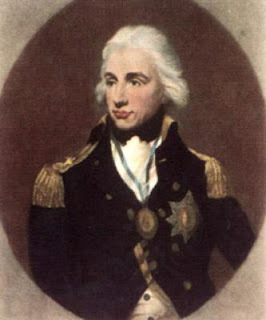
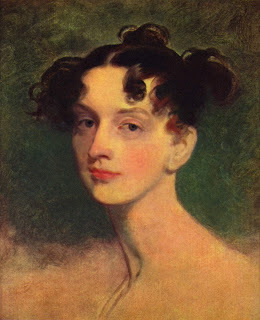
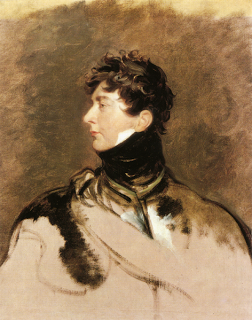
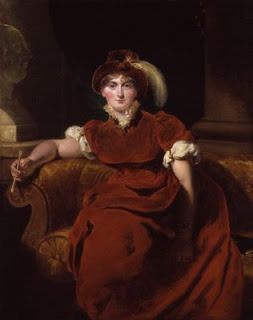
And our favorites . . . . .
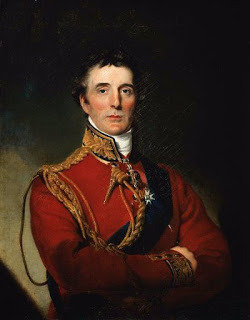
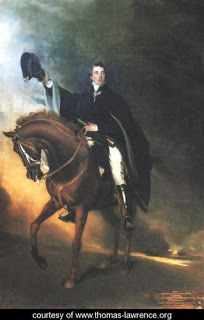
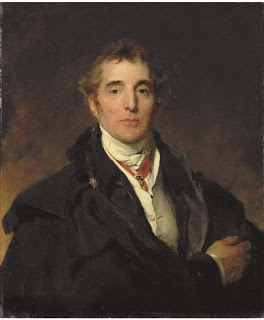
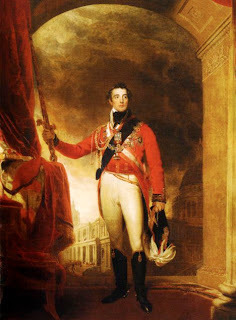
I can only hope that at least one of the Wellington portraits will be on view when I visit the Exhibition in London in December.
Published on October 20, 2010 02:49
October 18, 2010
Do You Know About Midsomer Murders?
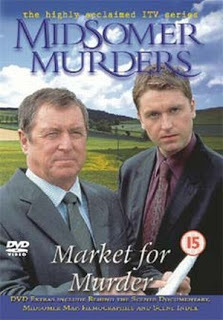 Midsomer Murders debuted on television in the U.K. on March 23, 1997 and to date there are about 85 episodes of the hugely popular series and counting. Midsomer Murders follows the investigations of Detective Chief Tom Barnaby (John Nettles) in the fictional English county of Midsomer. In the early seasons, his junior is Sergeant Gavin Troy (Daniel Casey), a mildly bumbling foil. but In later seasons, DCI Barnaby is assisted by DS Dan Scott, and currently by DS Ben Jones. Midsomer Murders is notable for its carefully crafted stories that revolve around the facade of a seemingly peaceful countryside that conceal all manners of vice and crime, including, but by no means limited to - blackmail, sexual deviances, suicide and murder. The Queen herself is rumoured to be a fan of the show, while John Nettles was awarded an OBE (Order of the British Empire) this past June during the Queen's birthday honours.
Midsomer Murders debuted on television in the U.K. on March 23, 1997 and to date there are about 85 episodes of the hugely popular series and counting. Midsomer Murders follows the investigations of Detective Chief Tom Barnaby (John Nettles) in the fictional English county of Midsomer. In the early seasons, his junior is Sergeant Gavin Troy (Daniel Casey), a mildly bumbling foil. but In later seasons, DCI Barnaby is assisted by DS Dan Scott, and currently by DS Ben Jones. Midsomer Murders is notable for its carefully crafted stories that revolve around the facade of a seemingly peaceful countryside that conceal all manners of vice and crime, including, but by no means limited to - blackmail, sexual deviances, suicide and murder. The Queen herself is rumoured to be a fan of the show, while John Nettles was awarded an OBE (Order of the British Empire) this past June during the Queen's birthday honours. 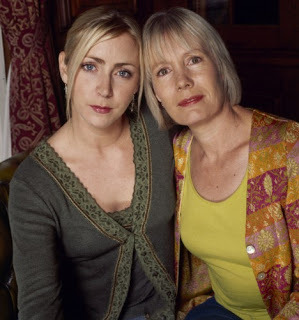
Jane Wymark (above right) plays Barnaby's patient wife Joyce, who occassionally finds herself unwittingly near the scene of a crime. Laura Howard (above left) plays Barnaby's daughter Cully, an aspiring actress.
Midsomer Murder is based on the novels by Caroline Graham, with scripts written by some of Britain's best television writers. John Nettles said: "There's something warped about the nature of our writers, they come up with extraordinary ways of killing people."
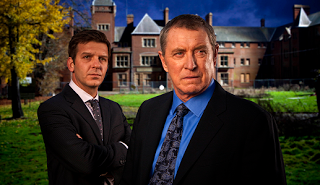
The action in these decidedly tongue-in-cheek scripts takes place in cozy village locations, replete with stately manor homes and chocolate box cottages. Don't let the bucolic settings fool you - you'll soon be shown what evil lurks in the hearts of men. In an episode called Judgment Day, Joyce is chosen to judge a "perfect village" competition, but things are far from perfect in the village of Midsomer Mallow when womanising tearaway Peter Drinkwater (Orlando Bloom) is stabbed to death with a pitchfork. In Hidden Depths egotistical lawyer Otto Benham (Oliver Ford Davies) is drugged, trussed and made into a human target in the middle of his croquet lawn, then fired on with bottles of his favourite vintage wine from a replica Roman catapult.
Midsomer Murders benefits from a topnotch lineup of guest appearances, such as Richard Briers (Good Neighbors), Prunella Scales (Fawlty Towers), Timothy West (Iris), Anna Massey (The Pallisers), Una Stubbs (Till Death Us Do Part), Michele Dotrice (Vanity Fair), Trudie Styler (The Mayor of Casterbridge), Robert Hardy (War and Remembrance, All Creatures Great and Small) and Maggie Steed (Lipstick on Your Collar).
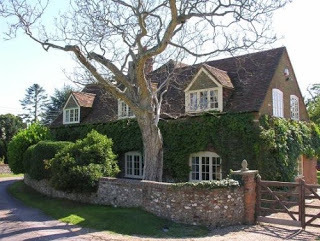
Guest appearances are also made by some of England's most gorgeous scenery, a subject covered in a book called Midsomer Murders On Location by Sabine Schreiner and Joan Street - 'The majority of the pretty villages that make up Midsomer country are actually strewn over four counties - Buckinghamshire, Berkshire, Hertfordshire and Oxfordshire. Here for the first time is a comprehensive guide to the gorgeous locations used in the filming of the series.'

Recently Nettles announced he'd be leaving the series after thirteen years and will be replaced by Neil Dudgeon, who will step in as Barnaby's cop cousin, John Barnaby. In an interview Nettles said, "I wanted to die in noble fashion in the service of my country and then be buried with full military honours in Westminster Abbey. In the event, Tom and his long-suffering wife Joyce will simply retire. It's always better to leave when people want more."
The show has garnered itself legions of diehard fans. Visit the Midsomer Murders comprehensive - and regularly updated - fan page here.
And get a taste for Murder with this episode clip.
Published on October 18, 2010 02:06
October 17, 2010
Excerpts from The Court Journal: Court Circular & Fashionable Gazette, Volume 5
COURT AND FASHIONABLE LIFE - October 1833
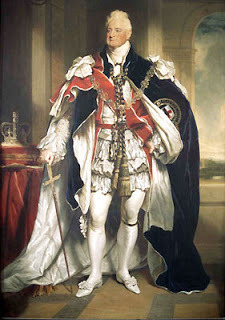 King William IV
King William IV
— On Sunday morning, the King and Queen, the Princess Augusta, and the Royal Suite and Household, attended Divine Service in the Chapel of the Castle. The Bishop of Worcester officiated.
In the evening Captain Ross and his nephew arrived at the Castle to pay their respects to his Majesty. They were received by the King in a very flattering and gracious manner, and had the honour of being introduced to the Queen and Royal visitors, with whom they dined and spent the evening. Captain Ross appeared in excellent health, and wore a Swedish Order.
— On Monday the King honoured the Earl and Countess of Albemarle with his company, at Hampton Court Palace. His Majesty arrived at Bushey about ten o'clock, where he was received by the Noble Earl; and after inspecting the paddocks and the Royal stud, returned to the Stud house, where his Majesty partook of a magnificent dejeuner a lafouchette. At half-past three o'clock, the King, attended by some of the distinguished visitors who were invited to meet his Majesty, visited the Palace at Hampton Court; and, at five o'clock, his Majesty returned to Windsor Castle.
— On Tuesday evening the marriage of the Hon. Mr Wellesley with the Hon. Olivia de Roos, was solemnized at Windsor Castle. The ceremony was performed by the Bishop of Worcester, assisted by the Rev. Isaac Gosset, Chaplain to their Majesties, in the private chapel, which was fitted up with crimson velvet for the occasion. There were present the King and Queen, the Duke of Wellington, Lady Sydney, Lord and Lady and Miss Cowley, Colonel and Lady and Miss de Roos, Lord and Lady Errol, Sir Herhcrt and Lady Taylor, and the Hon. Misses Mitchell, Johnstone, Eden, Boyle, and Bagot, Maids of Honour, and many of the Household. The bride was dressed in white satin and lace, and wore a beautiful head-dress of diamonds. His Majesty gave her away, and Lady Georgina Howe and Miss Taylor were the bridesmaids. At nine o'clock in the evening the bride and bridegroom left for Bushey ; and early next week they take their departure for Germany.
-On Wednesday, tbe King, attended by Sir Herbert Taylor, arrived at St James's Palace, for the purpose of holding a court. The following Foreign Ministers had audiences of his Majesty, viz :—The Baron Bulow, the Prussian Minister, to deliver a letter from his Sovereign; Prince Soutzo, Minister on a Special Mission from the King of Greece, to take leave ; Chevalier de Vial, the Spanish Minister, to deliver liis credentials from his new Sovereign; Marquis de Funchal and the Chevalier dc Lima, to deliver credentials from their new Sovereign. Viscount Palmerston presented Mr Addington to the King, on bis return from his mission to the Court of Madrid. Tbe King gave audiences to the Duke of Richmond, Viscount Melbourne, the Right Hon. Charles Grant, Mr Secretary Stanley, Viscount Palmerston, Sir James Graham, and Lord Hill,also to the Hanoverian Minister, Sir Lowry Cole (late Governor of the Cape of Good Hope), and Captain Woolmore.
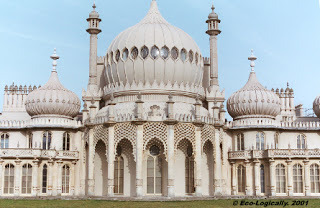 Brighton Pavilion The King and Queen will leave Windsor at an early hour this morning for the Pavilion at Brighton, where a large party are invited to meet their Majesties in the evening. They will travel direct to Brighton without passing through London. Part of the Royal household have been at the Pavilion for some days making the requisite preparations for the reception of their Majesties.
Brighton Pavilion The King and Queen will leave Windsor at an early hour this morning for the Pavilion at Brighton, where a large party are invited to meet their Majesties in the evening. They will travel direct to Brighton without passing through London. Part of the Royal household have been at the Pavilion for some days making the requisite preparations for the reception of their Majesties.
— The Marchioness of Wellesley, on her way to Dublin, stayed several days at Chatsworth, on a visit to the Duke of Devonshire, who is at present surrounded by his noble relatives. The Duke, we are happy to be informed, is nearly recovered from his lameness.
— Beaudesert, in Staffordshire, the splendid seat of the Marquis of Anglesey, is now occupied by his Lordship's eldest son, the Earl of Uxbridge, and his Countess. On the return of the Noble Marquis from his government in Ireland, and previous to his departure for Italy, he remained a few days in his pleasant and peaceful residence, Beaudesert.
— The Earl of Stair, during the winter, intends giving a series of grand entertainments at Paris, to all the British Noblesse sojourning there. His Lordship, although nearly a constant resident in the French capital, still retains his splended residence in Seamore Place, Curzon Street.
— The Hon. W. Clifford, who has recently taken possession of the mansion and estate at Irnham, near Bourne, Lincolnshire, gave a very elegant ball and supper on Wednesday to a numerous party of his tenantry.
— A very handsome guard-room for officers has just been erected in the King's mews, north of tbe new barracks.
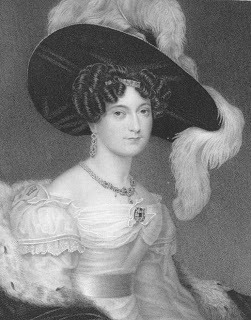 The Duchess of Kent
The Duchess of Kent
- The Duke and Duchess of Northumberland have been entertaining large parties of noble friends at their princely Palace at Alnwick, where it is their intention to remain until after Christmas. The Duchess of Kent and the Princess Victoria some time since contemplated a visit to the Noble Duchess in the north, but the genial breezes of the Isle of Wight have so exceedingly renovated the health of the young Princess, as to occasion the Duchess of Kent to remain on the island beyond the period originally contemplated. The Royal visit to Alnwick Castle is therefore deferred until next year.
— The Earl of Egremont is, next to Royalty, the greatest benefactor Brighton ever had. Should the Chain Pier be re-instated, it will owe its restoration entirely to the Noble Earl. Nearly all the improvements in that fashionable retreat have been suggested, and in part. carried into effect, by the liberality of his Lordship, whose private charities are also unbounded.
— Lord and Lady Lyndhurst have been passing some time in Paris, where her Ladyship excited the admiration of the beau monde in that gay and spirit-stirring capital. The learned Baron and his Lady during their stay frequently dined with the British Ambassador, and they remained in Paris just long enough to bid adieu to Prince Talleyrand and the Duchess de Dino, previously to their departure for the south of France.
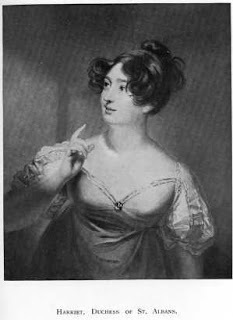
— The Duke and Duchess of St Albans have returned to their house in Piccadilly after a very long provincial tour, where in every town they visited, her Grace substantially patronized the theatre if there were one. They will shortly depart for Brighton for the winter, where they will resume their capacious house in Regency Square.
— The amiable Countess of Clare and her suite have again departed for the Continent, where they will remain until the spring of next year, unless news from her lord in India should occasion her Ladyship to return.
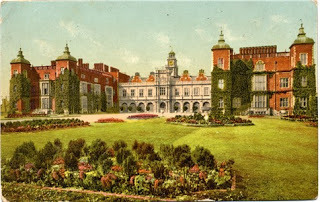 Hatfield House- Marquess and Marchioness of Salisbury, during the last fortnight, have been entertaining in succession large parties of the nobility at their mansion at Hatfield, one of the most splendid in that part of the country. The Noble Marquess will shortly review, on his own princely domain, the Hertfordshire Yeomanry, on which occasion the Duke of Wellington, and several of the Duke's military friends and 'companions in arms,' will likewise be present, to participate in the general and most unbounded hospitality which pervades Hatfield House at this annual festival. Lord and Lady Dacre, Lord Verulam, Lord Grimstone, and most of the opulent and distinguished neighbours are also invited
Hatfield House- Marquess and Marchioness of Salisbury, during the last fortnight, have been entertaining in succession large parties of the nobility at their mansion at Hatfield, one of the most splendid in that part of the country. The Noble Marquess will shortly review, on his own princely domain, the Hertfordshire Yeomanry, on which occasion the Duke of Wellington, and several of the Duke's military friends and 'companions in arms,' will likewise be present, to participate in the general and most unbounded hospitality which pervades Hatfield House at this annual festival. Lord and Lady Dacre, Lord Verulam, Lord Grimstone, and most of the opulent and distinguished neighbours are also invited
— Chantrey the Sculptor is at present engaged on a professional tour in the north. He has received instructions from the Dowager Viscountess Downe, to execute a full-length statue of her deeply lamented Lord, which is intended to be placed in Snaith Church, Yorkshire. The figure will be taken from a picture painted by Sir Thomas Lawrence, in which Lord Downe is represented in his parliamentary robes.
— The Duke and Duchess of Argyll will occupy a house at Brighton, in order to be near their Majesties, with whom his Grace is an especial favourite.
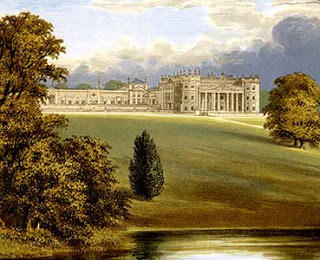 Bowood House- The Marquis and Marchioness of Lansdowne have been entertaining a large party of fashionables at Bowwood Park. We understand that, if the state of public business will permit, his Lordship and family will pay their annual visit to Paris before Christmas.
Bowood House- The Marquis and Marchioness of Lansdowne have been entertaining a large party of fashionables at Bowwood Park. We understand that, if the state of public business will permit, his Lordship and family will pay their annual visit to Paris before Christmas.
— Lord Delamere has been entertaining a large party of fashionables, at his seat, Vale Royal, Cheshire, to celebrate the coming of age of his Lordship's eldest son, the Hon. Hugh Cholmondeley, late of the 1st Life Guards.
— The Marquis and Marchioness of Conyngham are now in possession of the large mansion, in Park lane, built by the late Earl Dudley, from whose executors it was purchased by Lord Conyngham. We believe the Noble Marquis first intended to take the wine, which was valued at two thousand pounds; but this his Lordship has subsequently relinquished. The entire house has been newly-embellished, under the good taste and direction of the Marchioness of Couyngham.
— The Duke of Devonshire, the Marquis of Bristol, and the Marchioness and the Ladies Cornwallis, are the only distinguished personages that at present occupy houses at Kemp-town, near Brighton. The keen air of the west cliff is better suited for a summer than a winter residence.
— A happy family party, consisting of the Marquis and Marchioness of Ailesbury, Lady Laura Tollemache, Hon. Charles and Mrs Tollemache, and Miss Tollemache, are assembled under the roof of the excellent Countess of Dysart, and enjoying her hospitalities, enlivened occasionally by the visits of the surrounding neighbourhood.
— Few persons went to the last levee with greater magnificence than the Portuguese Ambassador, the Marquis of Funchal, and the Charge d'Affaires, M. de Lima. The liveries of the Marquis were nearly covered with silver lace. The reception of these gentlemen by the King was highly gratifying; his Majesty conversed with them for some time, and enquired particularly after the health of his ' little favourite," Donna Maria, and the Duchess of Braganza. His Majesty said he was rejoiced to hear of the continued success of the constitutionalists, and hoped that the contest would be soon over.
— Lord Yarborough has arrived at his seat, Brocklesby, for the burning season.
— It was the intention of the King and Queen of Belgium to visit Claremont this year, but they have been prevented. As the Queen, however, is very desirous of spending two or three weeks, the King will probably bring her over next Spring. The improvements in the Royal gardens and grounds in Belgium are proceding rapidly, under the superintendance of the King's Conservator, Mr Mackintosh.
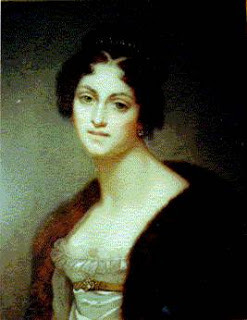
— The Duchess de Dino, since her departure, has written to several of her distinguished friend, to say that she expects to return to London early in January, accompanied by her daughter.
— The Duke of Grafton has been entertaining a party of his sporting friends with a grand latte, at his magnificent set, Euston Hall, near Timford. Amongst his Grace's distinguished guests are the Marquis of Exeter, Count Matuscberiu, the Earl of Chesterfield, the Earl of Stradbroose, Lord C. Fitzroy, Hon. Colonel Anson, &c.
— Earl and Countess Grey and family are still remaining at Howick, and no day has yet been named for their return to Downing Street.
 King William IV
King William IV— On Sunday morning, the King and Queen, the Princess Augusta, and the Royal Suite and Household, attended Divine Service in the Chapel of the Castle. The Bishop of Worcester officiated.
In the evening Captain Ross and his nephew arrived at the Castle to pay their respects to his Majesty. They were received by the King in a very flattering and gracious manner, and had the honour of being introduced to the Queen and Royal visitors, with whom they dined and spent the evening. Captain Ross appeared in excellent health, and wore a Swedish Order.
— On Monday the King honoured the Earl and Countess of Albemarle with his company, at Hampton Court Palace. His Majesty arrived at Bushey about ten o'clock, where he was received by the Noble Earl; and after inspecting the paddocks and the Royal stud, returned to the Stud house, where his Majesty partook of a magnificent dejeuner a lafouchette. At half-past three o'clock, the King, attended by some of the distinguished visitors who were invited to meet his Majesty, visited the Palace at Hampton Court; and, at five o'clock, his Majesty returned to Windsor Castle.
— On Tuesday evening the marriage of the Hon. Mr Wellesley with the Hon. Olivia de Roos, was solemnized at Windsor Castle. The ceremony was performed by the Bishop of Worcester, assisted by the Rev. Isaac Gosset, Chaplain to their Majesties, in the private chapel, which was fitted up with crimson velvet for the occasion. There were present the King and Queen, the Duke of Wellington, Lady Sydney, Lord and Lady and Miss Cowley, Colonel and Lady and Miss de Roos, Lord and Lady Errol, Sir Herhcrt and Lady Taylor, and the Hon. Misses Mitchell, Johnstone, Eden, Boyle, and Bagot, Maids of Honour, and many of the Household. The bride was dressed in white satin and lace, and wore a beautiful head-dress of diamonds. His Majesty gave her away, and Lady Georgina Howe and Miss Taylor were the bridesmaids. At nine o'clock in the evening the bride and bridegroom left for Bushey ; and early next week they take their departure for Germany.
-On Wednesday, tbe King, attended by Sir Herbert Taylor, arrived at St James's Palace, for the purpose of holding a court. The following Foreign Ministers had audiences of his Majesty, viz :—The Baron Bulow, the Prussian Minister, to deliver a letter from his Sovereign; Prince Soutzo, Minister on a Special Mission from the King of Greece, to take leave ; Chevalier de Vial, the Spanish Minister, to deliver liis credentials from his new Sovereign; Marquis de Funchal and the Chevalier dc Lima, to deliver credentials from their new Sovereign. Viscount Palmerston presented Mr Addington to the King, on bis return from his mission to the Court of Madrid. Tbe King gave audiences to the Duke of Richmond, Viscount Melbourne, the Right Hon. Charles Grant, Mr Secretary Stanley, Viscount Palmerston, Sir James Graham, and Lord Hill,also to the Hanoverian Minister, Sir Lowry Cole (late Governor of the Cape of Good Hope), and Captain Woolmore.
 Brighton Pavilion The King and Queen will leave Windsor at an early hour this morning for the Pavilion at Brighton, where a large party are invited to meet their Majesties in the evening. They will travel direct to Brighton without passing through London. Part of the Royal household have been at the Pavilion for some days making the requisite preparations for the reception of their Majesties.
Brighton Pavilion The King and Queen will leave Windsor at an early hour this morning for the Pavilion at Brighton, where a large party are invited to meet their Majesties in the evening. They will travel direct to Brighton without passing through London. Part of the Royal household have been at the Pavilion for some days making the requisite preparations for the reception of their Majesties.— The Marchioness of Wellesley, on her way to Dublin, stayed several days at Chatsworth, on a visit to the Duke of Devonshire, who is at present surrounded by his noble relatives. The Duke, we are happy to be informed, is nearly recovered from his lameness.
— Beaudesert, in Staffordshire, the splendid seat of the Marquis of Anglesey, is now occupied by his Lordship's eldest son, the Earl of Uxbridge, and his Countess. On the return of the Noble Marquis from his government in Ireland, and previous to his departure for Italy, he remained a few days in his pleasant and peaceful residence, Beaudesert.
— The Earl of Stair, during the winter, intends giving a series of grand entertainments at Paris, to all the British Noblesse sojourning there. His Lordship, although nearly a constant resident in the French capital, still retains his splended residence in Seamore Place, Curzon Street.
— The Hon. W. Clifford, who has recently taken possession of the mansion and estate at Irnham, near Bourne, Lincolnshire, gave a very elegant ball and supper on Wednesday to a numerous party of his tenantry.
— A very handsome guard-room for officers has just been erected in the King's mews, north of tbe new barracks.
 The Duchess of Kent
The Duchess of Kent - The Duke and Duchess of Northumberland have been entertaining large parties of noble friends at their princely Palace at Alnwick, where it is their intention to remain until after Christmas. The Duchess of Kent and the Princess Victoria some time since contemplated a visit to the Noble Duchess in the north, but the genial breezes of the Isle of Wight have so exceedingly renovated the health of the young Princess, as to occasion the Duchess of Kent to remain on the island beyond the period originally contemplated. The Royal visit to Alnwick Castle is therefore deferred until next year.
— The Earl of Egremont is, next to Royalty, the greatest benefactor Brighton ever had. Should the Chain Pier be re-instated, it will owe its restoration entirely to the Noble Earl. Nearly all the improvements in that fashionable retreat have been suggested, and in part. carried into effect, by the liberality of his Lordship, whose private charities are also unbounded.
— Lord and Lady Lyndhurst have been passing some time in Paris, where her Ladyship excited the admiration of the beau monde in that gay and spirit-stirring capital. The learned Baron and his Lady during their stay frequently dined with the British Ambassador, and they remained in Paris just long enough to bid adieu to Prince Talleyrand and the Duchess de Dino, previously to their departure for the south of France.

— The Duke and Duchess of St Albans have returned to their house in Piccadilly after a very long provincial tour, where in every town they visited, her Grace substantially patronized the theatre if there were one. They will shortly depart for Brighton for the winter, where they will resume their capacious house in Regency Square.
— The amiable Countess of Clare and her suite have again departed for the Continent, where they will remain until the spring of next year, unless news from her lord in India should occasion her Ladyship to return.
 Hatfield House- Marquess and Marchioness of Salisbury, during the last fortnight, have been entertaining in succession large parties of the nobility at their mansion at Hatfield, one of the most splendid in that part of the country. The Noble Marquess will shortly review, on his own princely domain, the Hertfordshire Yeomanry, on which occasion the Duke of Wellington, and several of the Duke's military friends and 'companions in arms,' will likewise be present, to participate in the general and most unbounded hospitality which pervades Hatfield House at this annual festival. Lord and Lady Dacre, Lord Verulam, Lord Grimstone, and most of the opulent and distinguished neighbours are also invited
Hatfield House- Marquess and Marchioness of Salisbury, during the last fortnight, have been entertaining in succession large parties of the nobility at their mansion at Hatfield, one of the most splendid in that part of the country. The Noble Marquess will shortly review, on his own princely domain, the Hertfordshire Yeomanry, on which occasion the Duke of Wellington, and several of the Duke's military friends and 'companions in arms,' will likewise be present, to participate in the general and most unbounded hospitality which pervades Hatfield House at this annual festival. Lord and Lady Dacre, Lord Verulam, Lord Grimstone, and most of the opulent and distinguished neighbours are also invited— Chantrey the Sculptor is at present engaged on a professional tour in the north. He has received instructions from the Dowager Viscountess Downe, to execute a full-length statue of her deeply lamented Lord, which is intended to be placed in Snaith Church, Yorkshire. The figure will be taken from a picture painted by Sir Thomas Lawrence, in which Lord Downe is represented in his parliamentary robes.
— The Duke and Duchess of Argyll will occupy a house at Brighton, in order to be near their Majesties, with whom his Grace is an especial favourite.
 Bowood House- The Marquis and Marchioness of Lansdowne have been entertaining a large party of fashionables at Bowwood Park. We understand that, if the state of public business will permit, his Lordship and family will pay their annual visit to Paris before Christmas.
Bowood House- The Marquis and Marchioness of Lansdowne have been entertaining a large party of fashionables at Bowwood Park. We understand that, if the state of public business will permit, his Lordship and family will pay their annual visit to Paris before Christmas.— Lord Delamere has been entertaining a large party of fashionables, at his seat, Vale Royal, Cheshire, to celebrate the coming of age of his Lordship's eldest son, the Hon. Hugh Cholmondeley, late of the 1st Life Guards.
— The Marquis and Marchioness of Conyngham are now in possession of the large mansion, in Park lane, built by the late Earl Dudley, from whose executors it was purchased by Lord Conyngham. We believe the Noble Marquis first intended to take the wine, which was valued at two thousand pounds; but this his Lordship has subsequently relinquished. The entire house has been newly-embellished, under the good taste and direction of the Marchioness of Couyngham.
— The Duke of Devonshire, the Marquis of Bristol, and the Marchioness and the Ladies Cornwallis, are the only distinguished personages that at present occupy houses at Kemp-town, near Brighton. The keen air of the west cliff is better suited for a summer than a winter residence.
— A happy family party, consisting of the Marquis and Marchioness of Ailesbury, Lady Laura Tollemache, Hon. Charles and Mrs Tollemache, and Miss Tollemache, are assembled under the roof of the excellent Countess of Dysart, and enjoying her hospitalities, enlivened occasionally by the visits of the surrounding neighbourhood.
— Few persons went to the last levee with greater magnificence than the Portuguese Ambassador, the Marquis of Funchal, and the Charge d'Affaires, M. de Lima. The liveries of the Marquis were nearly covered with silver lace. The reception of these gentlemen by the King was highly gratifying; his Majesty conversed with them for some time, and enquired particularly after the health of his ' little favourite," Donna Maria, and the Duchess of Braganza. His Majesty said he was rejoiced to hear of the continued success of the constitutionalists, and hoped that the contest would be soon over.
— Lord Yarborough has arrived at his seat, Brocklesby, for the burning season.
— It was the intention of the King and Queen of Belgium to visit Claremont this year, but they have been prevented. As the Queen, however, is very desirous of spending two or three weeks, the King will probably bring her over next Spring. The improvements in the Royal gardens and grounds in Belgium are proceding rapidly, under the superintendance of the King's Conservator, Mr Mackintosh.

— The Duchess de Dino, since her departure, has written to several of her distinguished friend, to say that she expects to return to London early in January, accompanied by her daughter.
— The Duke of Grafton has been entertaining a party of his sporting friends with a grand latte, at his magnificent set, Euston Hall, near Timford. Amongst his Grace's distinguished guests are the Marquis of Exeter, Count Matuscberiu, the Earl of Chesterfield, the Earl of Stradbroose, Lord C. Fitzroy, Hon. Colonel Anson, &c.
— Earl and Countess Grey and family are still remaining at Howick, and no day has yet been named for their return to Downing Street.
Published on October 17, 2010 01:45
Kristine Hughes's Blog
- Kristine Hughes's profile
- 6 followers
Kristine Hughes isn't a Goodreads Author
(yet),
but they
do have a blog,
so here are some recent posts imported from
their feed.



